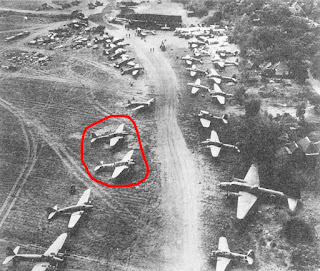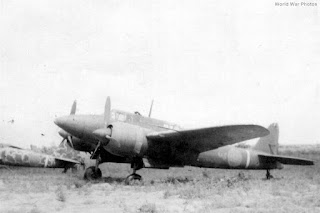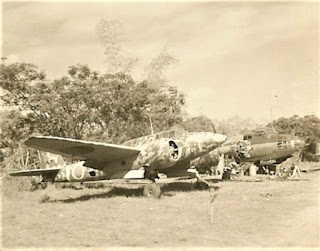There were two "Toryu" equipped units active in the Philippines during the last two years of the war. We examined the 27th Sentai in the previous post. In this post, we will take a look at the 45th Sentai.
The photo above featured in the Don Thorpe and Aircam books, shows a 45th Sentai Kawasaki Ki-45 "Toryu", in pristine condition, with its unit tail marking clearly visible and the number "37" at the base of the rudder. Behind it is the Ki-45 we saw in an earlier post, next to a prop/spinner and a wing, with the kanji "大" (dai) on its tail.
The 45th Sentai was organized on July 27, 1938, in Manchuria, from the 4, 6, and 11 Dokuritsu Chutai which became the units' 1st, 2nd, and 3rd Chutai respectively. Equipped with Kawasaki Ki-48 "Lilys", the unit was based in Rabaul's Kokopo airfield in January 1943, from where it launched attacks against Guadalcanal. From April 1943, the unit was based in But (or Lae according to other sources) Airfield taking part in the battle of East New Guinea.
In early December 1943, the unit returned to Japan and from the middle of the month started training with "Toryu" fighters at Hokota.
On February 6, 1944, left Japan and four days later arrived at Clark Field. End of February relocated to Wakde Island and spent about a month training and conducting patrol.
End of March returned to Clark Field, and for a while was assigned to ship escort duties. During the period from early July until August, the unit had about 20 operational Ki-45s. End of August the unit's strength was 26 aircraft escorting ships passing through the Bashi Channel between Taiwan and the Philippines.
During a particularly heavy raid against Japanese-held airfields on September 12, the unit, now based in Saravia Airfield on the northwest of Negros Island, was timely alerted and all its' operational aircraft took off to avoid getting hit on the ground. While in the air, they didn't encounter any enemy planes, but right after the 2nd Chutai and half of the 1st Chutai landed back in Saravia, they were attacked and strafed by F6Fs from the carrier USS Wasp. The "Toryu" of the 3rd Chutai and the remaining half of the 1st Chutai were still in the air and tried to attack the US planes. In the ensuing air battle, two Ki-45s were lost and another was badly damaged when it made an emergency landing. Following this, the remaining operational aircraft escaped briefly to Panay and Palawan Islands. The next day, the F6Fs returned and inflicted further damage to the unit's aircraft that had remained in Saravia.
In the middle of October 1944, the unit had about ten operational aircraft. When the US forces landed at Leyte Island on October 17, the 45 Sentai, based in Saravia together with elements of the 27th Sentai, launched attacks against the US forces. On the 19th, 45 Sentai "Toryu" fighters attacked the US Fleet but two planes failed to return. Following further missions against the US forces, by October 20, the unit had only 4-5 operational aircraft, and by October 24 only one Ki-45 remained. At the end of the month, the unit retreated to Silai Airfield where it received a few replacement aircraft and returned to attack the US forces in Leyte.
During the Leyte operations, the unit's Ki-45s carried 100kg bombs when they were attacking bigger targets like enemy ships or 50kg Ta-Dan bombs when their targets were enemy-held airfields. At that time, the "Toryu" were not organized to specific chutais but every capable pilot flew whichever plane was operational.
During the November 1~23 period, the unit had three aircraft shot down, nine seriously damaged and received 13 replacements but on November 23 the unit had only nine aircraft, only four of which were operational. By the end of November, the unit had lost 18 aircraft and received only eight replacements.
On December 14, 1944, the 45 Sentai organized a tokko (special attack, suicide) unit with ten members and formed the "Koka-tai" (Emperor's Flower Unit) with five members from the 208 Sentai.
By the end of December, the unit had no operational aircraft left, and the remaining pilots only, were transported to Angeles Airfield. Around that time the remaining members of the 27th and the 45th Sentai with whatever Ki-45s could be found, merged and launched attacks against the US forces landing at Mindoro Island.
On January 15, 1945, the unit received orders to return to Japan and did so in the same manner we described for the 27th Sentai.
The unit finally managed to return to Hokota on January 25, where the union of the two sentai became official. In April 1945, the 27th Sentai was disbanded and all its remaining members joined the 45th.
As can be expected, "Toryu" "37" didn't stay intact for long.
Photo from Radek.
Here's another photo from Radek featuring a 45 Sentai "Toryu" found destroyed at Puerto Princesa, Palawan Island, which, as we saw above, the unit used as an emergency airfield.
Unfortunately, the tail number has been removed by souvenir hunters.
Remember this Ki-45, also in pretty good condition?
Sadly, this is how it looked after a while.
As we saw in previous posts and above, there were several Ki-45s with the kanji "大" (dai) on their tail.
These were not the only Ki-45s found at Clark Field with kanji on their tails.
This one we first saw in the color photo in the "Shoki" post, has the kanji "宮" (miya) on its tail.
The name of the 2nd Chutai commander of the 45th Sentai, was Miyazaki, so it is possible that this was his personal aircraft.
This Ki-45 has the kanji "山" (yama) on its tail.
The name of the 3nd Chutai commander of the 45th Sentai, was Yamauchi, but he perished in October 1944. It could be one of his personal aircraft or, since the kanji for "yama" is quite common in many Japanese names, it could be the personal mount of another pilot.
This leaves us with the aircraft with the mysterious kanji "dai". After exhausting research, we finally discovered that the name of the 1st Chutai commander was Kamiyama or Koyama which, unfortunately, is no match for the "dai" kanji. So, as of this post, the identity of the aircraft with the "dai" kanji remain unknown.
BUT, there were other Ki-45s in Clark Field with katakana on their tails.
This one has the katakana "ア" (a) on its tail.
More coming up. Stay tuned.



































































